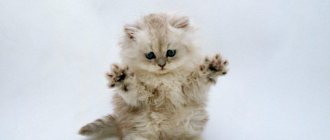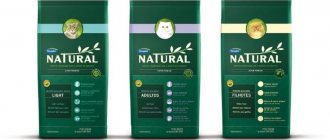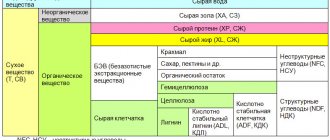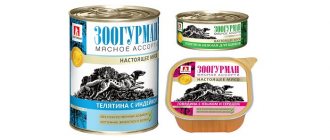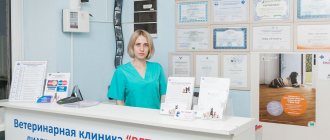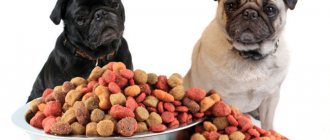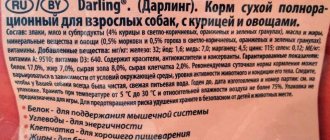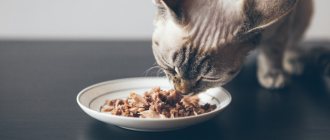History of appearance
Prepared animal feed began to be produced in the 1860s. English electrician James Spratt invented the “dog biscuit”, which included beef blood, wheat and vegetables. These were the first crackers for pets; soon many businessmen picked up the idea and began producing similar products. In the 1890s, know-how migrated to the USA.
At the beginning of the 20th century, prepared pet foods became popular; the first canned food for cats was released in the 30s by Gaines Food.
In the 1940s, dry food also appeared. Since the metal was used to meet the needs of the front, canned food for animals was not produced. But the producers did not want to give up their profitable business, and therefore switched to dry products.
At that time, there were two types: granules (sold ready-made) and balls (they had to be kneaded by hand).
After the war, people's well-being improved, and they could already afford to purchase food for four-legged animals. Many companies have added this position to their product manufacturing. These were Mars, Lipton, Quaker Oats, Post, Carnation, etc. Most canned foods back then were fish.
A new milestone in the history of animal feed was the introduction of new technology in the 50s by Purina. This was using extrusion, a process of preparing feed by pushing it through an extruder. As a result of this treatment, the finished product seemed to be swollen, increased in volume, after which it was baked. Manufacturers used the new technology as a marketing ploy, offering more food for the same money, but the benefits of such products were questionable. Firstly, the crackers were sprinkled with flavorings, and secondly, a large amount of starch was added to the extrusion mixture - mostly corn.
Later, manufacturers contributed to an active educational campaign for pet owners, promoting the harmfulness of food from the owners’ tables for cats, thereby trying to increase sales of their products.
Who controls feed manufacturers?
Many popular brands of cat food come from the USA. Manufacturers in the United States are regulated at the federal level by the Food and Drug Administration (FDA). It operates under the Federal Food, Drug and Cosmetic Act.
In turn, within the FDA, the Center for Veterinary Medicine (CVM) is responsible for the control of pet food products. And this control does not concern standards for feed, but exclusively medicines for animals, food additives and medicinal feeds (and then, for the most part, for livestock, and not for cats and dogs).
The FDA carries out its responsibilities in partnership with the American Association of Animal Feed Control Officers (AAFCO). This organization is practically independent of government control, it does not have an enforcement agency, and it does not conduct analytical tests of feed.
And most importantly, pet foods do not have to be approved before being put on the market. The manufacturer is only required to comply with the regulations in force in the state where he produces or sells his feed.
In our time
Over the course of a century and a half, industrial animal feed has undergone significant changes, but not all owners are inclined to trust ready-made diets, doubting the quality of the original products. Therefore, owners continue to feed cats “human” food. Is this acceptable? And what is better for four-legged pets - ready-made food or natural products? This issue needs to be carefully looked into so as not to risk the health of our little brothers. To understand whether prepared foods are healthy, you need to understand what they are actually made from.
When choosing a product to feed your pet, it is important to analyze the composition of the first one by carefully reading the labels on the packaging. What is dry cat food made from?
Current State of the Animal Feed Industry
Over the past 20 years, the animal feed industry has become increasingly closer to the food industry both in technology and in the quality of ingredients used. Manufacturers are required to publish the true composition of each product, the percentage of main components and their sources; raw materials undergo mandatory quality and safety checks.
Owners are increasingly placing the same high demands on food for their dogs and cats as they do on their own food. Thanks to this, manufacturers are developing new technologies to produce higher quality feed, increasing the percentage of meat in their diets, and using natural preservatives.
At the same time, it is important to remember that the body of dogs and cats is different from the human body, and this must be taken into account when choosing what to feed your pet.
Meat
The main ingredients in the composition are components of animal origin. These include not only meat itself, but also offal, fish and eggs. It is a source of protein for four-legged animals. The cat's body best absorbs amino acids from poultry, as well as fish, lamb and beef. This does not mean that the animal should not be given other types of meat food. If there are no allergies and the food is well digested, it is worth diversifying the menu by offering different types of crackers.
On the food package this ingredient may be written under the word “Meat”. This also includes animal muscle tissue, which may include fat, tendons, blood vessels, and skin. The “meat” is subjected to mechanical deboning, grinding into minced meat. The poultry and fish in the composition are usually isolated; they cannot be called “meat”. What else goes into ready-made animal food?
Table of comparative analysis of feed by class
Characteristics of industrial cat food are given in the table.
| Characteristic | Trademark | % meat content | Price 1 kg, rub. |
| Economy | |||
| They contain by-products from meat ingredients, and low-quality grains and soy from vegetable ingredients. Additives include many carcinogens and artificial flavors. The cheapest and most undesirable class of food for a cat’s diet. Lead to indigestion, allergies, and chronic diseases. Sold in all supermarkets and widely advertised. | Whiskas, Friskas, Kitekat, Darling, Felix, Cat Chow (Cat Chow), Purina Van (Purina One), Perfect Fit (often classified as premium, but it does not reach it) | From 4 to 6 | From 80 |
| Premium | |||
| Average quality ingredients used. Quite a high content of animal proteins. Well absorbed by the cat's body with the least amount of indigestible waste. The cost is 20-50 percent higher than economy class. Most often sold in pet stores. | 1st Choice, Happy Cat, Hills, Proplan, Royal Canin, Yams, Probalance | From 10 to 20 | From 250 |
| Super premium | |||
| They have a balanced composition, high nutritional value, and are completely absorbed by the cat’s body. Contains natural meat and high-quality cereals. They do not contain artificial additives, taste improvers or carcinogenic substances. Expensive. Sold only in pet stores. | Monge, Leonardo, Bozita, Nature's Protection | 50 or more | From 700 |
| Holistics | |||
| Protein - only fresh and dehydrated meat and fish. No plant materials. Carbohydrates - potatoes, rice, peas, lentils. No corn, wheat. Only natural preservatives (tocopherols). Fiber - vegetables, fruits, dried berries. Hypoallergenic product. Sold only in specialized pet stores. | Akana, Orijen, Go Natural! (Go Natural), Now, Golden Eagle Holistic Health (Golden Eagle Holistic), Pronature Holistic | 50 and above | From 1450 |
Instead of meat
What else is included in cat food?
- Meat by-products. These are the remaining edible parts of mammals, for example, liver, kidneys, tripe. There may also be lungs and udders, although they are not edible for humans, animals can eat them.
- Bird. This refers to all edible parts of birds, except feathers, entrails, heads and legs. This also includes bones and skin. They are ground together with the pulp, and the bones are also a valuable source of calcium. The manufacturer often indicates the type of poultry - chicken, turkey.
- Poultry by-products. This includes heads, legs and intestines, as well as the heart, liver and stomach.
What is cat food made from? Inexpensive products called “Meat” and “Poultry” use by-products at best.
What to look for when choosing cat food
When you go to a pet store for the first time, it’s not surprising to be overwhelmed by the huge variety of cat food on offer. But in order to make the right choice, you still need to have a cool head on your shoulders and, when choosing food for your family pet, focus not only on beautiful packaging and reasonable cost, but also on analyzing cat food on the following points!
- If you don’t yet understand food brands, then pay attention to the country of origin. By all accounts, the best food is made in Denmark, Germany, Canada, the USA and the UK.
- Advanced cat owners need to pay attention to the brand of food. The reputation of some foods is very tarnished, while others, on the contrary, are undeservedly deprived of the attention of buyers. You can learn more about this in the article rating dry cat food.
- But the most important thing in any food is the composition. We will teach you how to read, analyze and compare cat food and instantly assess its real benefits or harm.
Flour
Flour or hydrolyzed product. What is found under this name in animal feed? During the processing process, moisture, fat, bacteria, and microorganisms are removed from the components under the influence of high temperature and pressure. Only proteins and minerals remain, they are ground to powder. The resulting powder is called “flour” or “hydrolyzed” product.
- Meat meal is a powder obtained from the processing of mammalian tissue, and not only muscle tissue. Thus, meat flour can be produced not only from meat, but also from offal. Mammals may be different; the manufacturer may indicate their species, but this is not necessary.
- Meat and bone meal. Almost the same as meat meal, but it also contains crushed bones. The manufacturer indicates the amount of minerals and nutrients, but does not have to indicate from whom the flour was obtained.
- Flour from animal by-products. It is obtained from meat, bones and offal. The starting raw material can be whole mammal carcasses.
- Poultry by-product meal. This component is obtained from whole poultry carcasses or their by-products. The raw materials are crushed and processed to remove moisture and fat. The result is a protein-mineral ingredient.
- Poultry meal. It is obtained by processing an ingredient called "Poultry". What is cat food made from and what else is present in its composition?
Cereals
This component is often present in economy and premium food. Its presence in high-quality feed is not welcome, since there are not many vitamins in cereals, and they are quite capable of causing the development of allergies. Corn and wheat are the most dangerous in this regard. In cats, this can result in unreasonable itching and hair loss.
Probiotics and prebiotics
Some foods contain probiotics and prebiotics. Probiotics are live microorganisms that improve digestion, normalize intestinal microflora and strengthen the immune system.
Prebiotics are food for beneficial bacteria: not digested in the stomach and upper intestine, they enter the lower intestine and contribute to the development of a balanced microflora. Prebiotics include fiber found in grains and vegetables, as well as inulin.
Using probiotics in dry food is not an easy task, as many microorganisms are unable to survive at extrusion temperatures, but there are also resistant strains. These, for example, include Bacillus subtilis (bacillus hay) and Bacillus licheniformis, which are common in soil.
These microorganisms are especially useful for urban animals, especially cats that never leave the apartment.
Vitamins and minerals
The processed raw materials from which cat food is produced are a source of proteins and carbohydrates. Vitamins and minerals are not preserved after processing, so they are added artificially. The manufacturer describes them:
- by simple enumeration - copper, iron, sodium, zinc, calcium;
- indicating specific substances containing minerals.
The sources of minerals are synthetic additives: iron amino acid complex, zinc polysaccharide complex. It is believed that minerals are better absorbed from such compounds.
Vitamins are also added in the form of artificial substances: cholecalciferol (vitamin D from animal sources), ergocalciferol (vitamin D from plants), riboflavin (vitamin B2), vitamin A, vitamin E, thiamine mononitrate (source of vitamin B1), vitamin B6.
So, behind complex chemical names are hidden artificial analogues of natural components that disappeared from the feed during processing. Amino acids (DL-methionine, L-lysine, DL-tryptophan) are also replaced.
How to accustom a cat to new food
When changing your diet, a smooth transition is necessary. This way you can avoid digestive disorders.
Rules for transferring to a new diet:
- gradually reduce portions of the previous food;
- increase the amount of natural product;
- for training, use one recipe for homemade food, only after getting used to it, add new products;
- During the first days you should monitor your pet; if digestive problems arise, change the components of the homemade food;
- if you have a poor appetite, it is permissible to feed by hand or warm it up to a slightly warm state (the cat is a predator and for it the normal food temperature is the temperature of a freshly killed carcass).
You can switch the animal to natural food within 1-2 weeks.
Feeding rules
To keep your animal healthy, it is important to follow basic nutritional rules:
- The pet should be fed at the same time, 2-3 times a day. Kittens should be fed 5-6 times a day.
- Provide access to water around the clock.
- If symptoms such as vomiting, diarrhea, lethargy, or fever appear, contact your veterinarian immediately.
- After eating, the cat often requires rest; you should not disturb it.
- Uneaten food must be disposed of - it quickly deteriorates and becomes dangerous for the animal, in addition, with constant access to food, cats can overeat.
Be sure to read:
What is cat food made from: how is it made wet and dry, can you make it yourself?
It is better to discuss the composition of homemade food with your veterinarian. He will suggest the most balanced types of nutrition, taking into account the characteristics of the pet. Food for kittens, adult cats or sterilized animals differs in composition. All ingredients must be fresh and of high quality.
How to cook food for a cat
All components must be heat treated. The meat can be thoroughly frozen. Veterinarians do not recommend adding raw meat purchased at the market. It contains antibiotics and additives that are harmful to the cat. Also, experts do not recommend using ready-made minced meat.
Since there is not enough taurine in food, which
To provide your pet with carbohydrates, cereals are added to the food: rice, buckwheat, oatmeal, wheat groats.
Mandatory foods in the diet
A healthy cat's diet should include the following foods:
- sources of protein (meat, meat products, fish, eggs);
- offal - beef or chicken liver, as well as kidneys and heart;
- fish oil or butter as sources of fat;
- dairy products: kefir, cottage cheese, cheese, yogurt, fermented baked milk (1-2 times a week);
- vegetables: green beans, carrots, cauliflower, zucchini, pumpkin.
Fish can be given both river and sea. Pork is prohibited for cats because it is considered too heavy and high in fat. May cause digestive disorders.
Eggs contain many useful microelements, but they should not be given more than once a week. It is also recommended to add half a teaspoon of vegetable oil, preferably corn or olive, to homemade food.
Preservatives
Of course, any feed contains substances that ensure long-term storage of the product. Possible preservatives include:
- ascorbic acid;
- benzoic acid,
- butylated hydroxyl anisole (BHA),
- butylated hydroxyl toluene (BHT),
- calcium ascorbate,
- lemon acid,
- ethoxyquin,
- potassium sorbate,
- sodium bisulfate,
- tocopherols.
It is the manufacturer's responsibility to indicate the preservative used.
How to distinguish quality food?
Meat should be first on the ingredient list. The preferred by-products are kidneys, heart, stomach, liver, and lungs. Tripe and chicken heads are acceptable in small quantities. Such components are included in super-premium and holistic food categories.
General names such as “Meat”, “Poultry”, “Offal” are not desirable. Under these names, various ingredients may be used, and of questionable quality. If the manufacturer avoids specifics, perhaps he wants to hide something from the consumer.
Extracts instead of the substances themselves in the feed are undesirable. For example, instead of meat, hydrolyzed animal proteins may be included. Often the share of meat ingredients can be no more than 4%, as happens in economy-class feeds. This is very little for predators, and therefore such products are not useful for pets.
Below is a comparison of cat food composition.
Is it possible to make food with your own hands: 5 stages of preparation
You can make an analogue of dry food at home, but you should not prepare large batches of food. Without the addition of preservatives, drugs that inhibit the growth of molds and bacteria, food cannot be stored for months, like the industrial version.
Meat (fish) food
To prepare you will need:
- Meat – 2 kg. Pork is contraindicated for cats; it is better to take beef, veal, and turkey. Offal products are good (liver, kidneys, lung, heart, cleaned stomachs). You can use sea fish (hake fillet, pollock, capelin, blue whiting, anchovy). It is not advisable to mix meat and fish in one serving; it is permissible to use different varieties of the same type of product.
- Vegetables – 0.5 kg. (carrots, beets, zucchini, broccoli).
- Egg – 3 pcs.
- Olive oil – 3-4 tablespoons.
- Rice (buckwheat) – 0.5 cups of the finished product.
Meat (fish) is separated from the bones, vegetables are washed and peeled. The solid components, the porridge, are passed through a meat grinder twice and crushed with a blender until pureed. Add raw eggs, cottage cheese, butter. Mix thoroughly.
Salt, pepper, spices, onions, and garlic are strictly prohibited from being added to the mixture. On the Internet you can find recipes for producing dry cat food based on canned fish. You should not put them into practice; human food contains spices, salt, and an abundance of fats that are harmful to cats.
Be sure to read:
The best food for kittens: premium and economy class
The baking sheet is greased with vegetable oil or covered with parchment or foil. Using a cake decorating bag, squeeze out sausages 1.5-2 fingers thick over the entire length of the sheet. Dry in the oven over low heat until it becomes breadcrumbs.
The finished sticks are crushed into small pieces. The food is stored in the refrigerator, packaged in bags for daily portions.
Royal Canin Adult British Shorthair
Belongs to the premium class. Royal Canin dry cat food contains plant protein isolate and dehydrated animal proteins (poultry), as well as hydrolyzed animal proteins and a natural flavor additive. In addition, rice, wheat and cereal flour act as carbohydrates. The fats used are animal oil, fish oil and soybean oil. The fiber used is vegetable. There is a mineral supplement, yeast, fructooligosaccharides.
Royal Canin cat food comes in a wide range of flavors and contains a large amount of vitamins and minerals. However, the price of the goods is not low.
How dry industrial mixtures are produced
Before a brand is approved for release, feline nutritionists work. They develop and approve the composition of the final product.
According to the finished recipe, all components are mixed in special units: meat, offal, vegetable raw materials, additional ingredients - preservatives, stabilizers, additives. The finished mass is pressed through a sieve, the cells of which have the shape of future granules.
After drying, the finished pieces are treated with a special composition - a mixture of fat and ingredients that give the food a taste that is attractive to the cat.
Meat after drying cannot occupy more than half the volume, its usual rate is lower - about 35 percent, therefore, if it is not in first place in the list on the product label, this is normal.
The advantage of any food is the absence of flavors and dyes, components that are clearly harmful to animals.
The daily intake of the mixture is also important - the lower it is, the more nutritious the food.
The moisture content of dry food is always no more than six percent.
"Felix" (in bags)
What is this brand of cat food made from? This is economy food. It contains meat and its processed products (4% chicken, 4% lamb). However, what kind of meat is included and how much of it is unknown. In addition, there is a vegetable protein extract, fish and its products, minerals, dyes, sugars, and vitamins. The advantages are considered to be affordable price and widespread availability. The disadvantages are that Felix cat food contains unknown components in unclear quantities.
"Whiskas"
Economy class product. What is Whiskas cat food made from? Its production uses chicken, fish meal, turkey, corn, rice, animal fat, vitamins and minerals, preservatives and flavorings.
Disadvantages of this brand of food:
- Whiskas cat food contains many ingredients of dubious quality, indicated by general formulations.
- A large number of plant components.
- It is unclear what flavorings and preservatives are contained.
- High percentage of potential allergens (corn, caramel).
Acana Grasslands for Cats
The food belongs to the holistic class. It contains lamb, lamb liver, lamb flour, salmon, eggs, lentils, herring flour, lamb and duck fat, apples, carrots, cranberries, pumpkin, peas, vitamins and minerals, dandelion, chamomile, mint.
The food is characterized by a high meat content, the presence of preventive additives, duck, fish and lamb fats.
So, having figured out what cat food is made from, we now understand that if you choose this option for feeding your cat, you should purchase high-quality products, since they contain components beneficial to the health of the animal.
